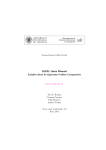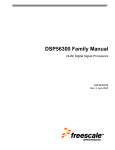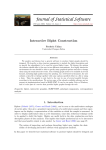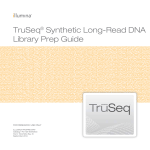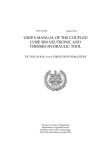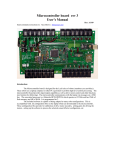Download MATRAN A Fortran 95 Matrix Wrapper
Transcript
University of Maryland
College Park
Institute for Advanced Computer Studies
Department of Computer Science
TR{2003{89
TR{4521
MATRAN
A Fortran 95 Matrix Wrapper
G. W. Stewarty
August 2003
ABSTRACT
Matran is an wrapper written in Fortran 95 that implements matrix operations and computes matrix decompositions using lapack and the blas.
This document describes a preliminary release of matran, which treats
only real matrices. Its purpose is to get outside comments and suggestions
before the package jells. Consequently, this documentation is slanted toward the experienced programmer familiar with both matrix computations
and Fortran 90/95. User oriented documentation will accompany the nal
release.
This
report is available by anonymous ftp from thales.cs.umd.edu in the directory pub/reports
or on the web at http://www.cs.umd.edu/stewart/.
y Department of Computer Science and Institute for Advanced Computer Studies, University of Maryland, College Park, MD 20742 ([email protected]). This work was supported in part by the National
Science Foundation under grant CCR0204084.
MATRAN
i
Contents
Preface
iii
1
Overview and example
1
2
The module MatranUtil m
8
3
The types Rmat and Rdiag
3.1 The type Rmat . . . . . . . . . . . . . . . . . . . . . . . . . . . . . . . .
3.2 The type Rdiag . . . . . . . . . . . . . . . . . . . . . . . . . . . . . . . .
11
16
4
Matrix Operations
17
5
Matrix miscellania
6
Decompositions
1.1 Overview . . . . . . . . . . . . . . . . . . . . . . . . . . . . . . . . . . .
1.2 A least squares solver . . . . . . . . . . . . . . . . . . . . . . . . . . . .
4.1
4.2
4.3
4.4
4.5
4.6
4.7
4.8
5.1
5.2
5.3
5.4
5.5
5.6
5.7
6.1
6.2
6.3
6.4
6.5
6.6
6.7
Generalities . . . . .
The Transpose suite
The Sum suite . . .
The Product suite .
The Solve suite . . .
The Join suit . . . .
The Border suit . . .
The Submatrix suite
.
.
.
.
.
.
.
.
.
.
.
.
.
.
.
.
.
.
.
.
.
.
.
.
.
.
.
.
.
.
.
.
.
.
.
.
.
.
.
.
The Diag suite . . . . . . . .
The Eye suite . . . . . . . . .
The Inverse suite . . . . . . .
The Norm and Norm2 suites
The Pivot suite . . . . . . . .
The Print suite . . . . . . . .
The Rand suite . . . . . . . .
.
.
.
.
.
.
.
.
.
.
.
.
.
.
.
.
.
.
.
.
.
.
.
.
.
.
.
.
.
.
Generalities . . . . . . . . . . . .
The LU decomposition . . . . . .
The Cholesky decomposition . .
The QR decomposition . . . . . .
The pivoted QR decomposition .
The spectral decomposition . . .
The singular value decomposition
.
.
.
.
.
.
.
.
.
.
.
.
.
.
.
.
.
.
.
.
.
.
.
.
.
.
.
.
.
.
.
.
.
.
.
.
.
.
.
.
.
.
.
.
.
.
.
.
.
.
.
.
.
.
.
.
.
.
.
.
.
.
.
.
.
.
.
.
.
.
.
.
.
.
.
.
.
.
.
.
.
.
.
.
.
.
.
.
.
.
.
.
.
.
.
.
.
.
.
.
.
.
.
.
.
.
.
.
.
.
.
.
.
.
.
.
.
.
.
.
.
.
.
.
.
.
.
.
.
.
.
.
.
.
.
.
.
.
.
.
.
.
.
.
.
.
.
.
.
.
.
.
.
.
.
.
.
.
.
.
.
.
.
.
.
.
.
.
.
.
.
.
.
.
.
.
.
.
.
.
.
.
.
.
.
.
.
.
.
.
.
.
.
.
.
.
.
.
.
.
.
.
.
.
.
.
.
.
.
.
.
.
.
.
.
.
.
.
.
.
.
.
.
.
.
.
.
.
.
.
.
.
.
.
.
.
.
.
.
.
.
.
.
.
.
.
.
.
.
.
.
.
.
.
.
.
.
.
.
.
.
.
.
.
.
.
.
.
.
.
.
.
.
.
.
.
.
.
.
.
.
.
.
.
.
.
.
.
.
.
.
.
.
.
.
.
.
.
.
.
.
.
.
.
.
.
.
.
.
.
.
.
.
.
.
.
.
.
.
.
.
.
.
.
.
.
.
.
.
.
.
.
.
.
.
.
.
.
.
.
.
.
.
.
.
.
.
.
.
.
.
.
.
.
.
.
.
.
.
.
.
.
.
.
.
.
.
.
.
.
.
.
.
.
.
.
.
.
.
.
.
.
.
.
.
.
.
.
.
.
.
.
.
.
.
.
.
.
.
.
.
.
.
.
.
.
.
.
.
.
.
.
.
.
.
.
.
.
.
.
.
.
.
.
.
.
.
.
.
.
.
.
.
.
.
.
.
.
.
.
.
.
.
.
.
.
.
.
.
.
.
.
.
.
.
.
.
.
.
.
.
.
.
.
.
.
.
.
.
.
.
.
.
.
.
.
.
.
.
.
.
.
.
.
1
3
9
17
19
20
20
22
23
23
24
25
26
26
27
28
29
29
31
32
32
35
36
36
38
39
40
ii
MATRAN
6.8 The real Schur decomposition . . . . . . . . . . . . . . . . . . . . . . . .
6.9 The eigendecomposition . . . . . . . . . . . . . . . . . . . . . . . . . . .
42
44
7
The real core
45
8
Computing Arnoldi decompositions
47
9
Appendix: The Sun Fortran 95 6.2 Compiler
54
MATRAN
iii
Preface
This document introduces a preliminary version of matran (pronounced MAY-tran),
a Fortran 95 wrpper that implements matrix operations and computes matrix decompositions using lapack and the blas. Although matran is not based on a formally
dened matrix language, it provides the avor and convenience of coding in matrix oriented systems like matlab, octave, etc. By using routines from lapack and the
blas, matran allows the user to obtain the computational benets of these packages
with minimal fuss and bother.
Matran originated as follows. In 2002, my colleague Dianne O'Leary and I received
an NSF grant to work on new algorithms for large-scale eigenvalue problems. Somewhat
rashly we promised to implement our algorithms in a standard high level language,
even though we knew that we would develop them using matlab. A couple of years
previously I had published a Java matrix package called jampack. The response was
less than enthusiastic, owing in part to the awkward syntax forced on it by the absence
of operator overloading in Java. Since Fortran 95 not only can overload operators but
can also can dene new ones, it occurred to me that jampack would look a lot cleaner
in Fortran 95 and could, in fact, provide natural and eÆcient implementations of code
from matrix oriented languages.
At present matran implements only real matrix operations and decompositions.
Consequently, it is still is small enough to survive signicant changes, provided they represent substantial improvements. The purpose of this release is to solicit comments and
suggestions before matran jells. For this reason, this document is addressed largely
to experts | people well grounded in matrix computations, Fortran 95, lapack, and
the blas. The formal release, which will contain complex types, will be accompanied
by a more conventional user's manual.
Matran may be obtained through my home page
http://www.cs.umd.edu/~stewart/
This project has many benefactors. I am supported by the National Science Foundation at the Computer Science Department and the Institute for Advanced Computer
Studies of the University of Maryland. I am also a faculty appointee at the Mathematical and Computational Sciences Division of the National Institute for Standards and
Technology, where my division leader, Ron Boviert, has encouraged me to work on this
project.
I am greatly indebted to John Reid, who patiently steered me through my initial
fumblings with Fortran 95 and provided useful suggestions for the design of matran.
His excellent book with Michael Metcalf, Fortran 90/95 Explained, has been my constant
companion during this project. Bill Mitchel, the resident NIST expert on Fortran 90/95,
has made himself cheerfully available on a drop-in basis to answer my questions. Finally,
iv
MATRAN
my student Che-Rung Lee, who came in at the middle of the project and quickly learned
the ropes, has been a valuable assistant ever since.
MATRAN
A Fortran 95 Wrapper for Matrix Operations
G. W. Stewart
1. Overview and example
Matran is an open wrapper written in Fortran 95 that implements matrix operations
and computes matrix decompositions using lapack and the blas. Matran is a
blending of \matrix" and \Fortran," and is pronounced MAY-tran. This document
describes a preliminary release of matran which treats only real matrices. Its purpose
to get outside comments and suggestions before the package jells. Consequently, it is
slanted toward the experienced programmer familiar with both matrix computations
and Fortran 90/95. User oriented documentation will accompany the nal release.
1.1. Overview
Matran is a collection of derived types and generic subprograms in Fortran 95 that
implements matrix operations and computes matrix functions and decompositions. Although matran is not based on a formally dened matrix language, the results of using
matran are akin to coding in a subset of matrix oriented programming languages like
matlab, octave, etc. By using routines from lapack and the blas, matran allows the user to obtain the computational benets of these packages with minimal fuss
and bother.
Here are some of the features of matran.
This preliminary release of matran provides only two matrix types. The Rmat represents matrices stored in rectangular arrays. The Rdiag implements diagonal matrices
stored in a linear array.1 However, this poverty of types is illusory. The type Rmat
contains a tag eld that subdivides the type into general, upper triangular, lower triangular, symmetric, and symmetric positive denite matrices. The rst formal release will
also include complex versions of the two types. Ultimately, I would like to see matran
support band and sparse matrices.
There are single and double versions of matran, corresponding to the single and
double precision versions of lapack and the blas. The default result of compilation is
double precision; but compilation of a single precision package can be forced by setting
a ag in the compilation command line. Unfortunately, one cannot mix or match: the
1
In Fortran 95 these arrays are said to have rank two and one respectively. However, since the word
rank has other meanings in matrix computations, we use the terms rectangular and linear instead.
1
2
MATRAN
package is all single precision or all double precision. Incidently, if lapack quad codes
become avaliable, it will be easy to extend matran to a quad package.
Matrix operations are provided by overloaded and dened operators. For example
A + B compute the sum of the matrices A and B , while A.xhy.B computes AH B . A
suite of subprograms computes products like A 1 B or A H B . In addition, matran
denes operations for combining matrices and extracting submatrices.
Matran provides common matrix functions | e.g., norms | as well as constructors
for special matrices like the identity.
Matrix types in matran are allowed to be void (aka empty) | that is, they may
have zero row or column dimension (or both). This feature is useful in starting matrix
algorithms that build up matrices by bordering.
Matran provides types for the following decompositions: the pivoted LU decomposition, the Cholesky decomposition, the pivoted and unpivoted QR decompositions,
the spectral decomposition of a symmetric matrix, the singular value decomposition,
and the Schur and eigendecompositions of a general square matrix. Matran provides
means for reusing decompositions, as, for example, when one wishes to solve several
linear systems all having the same matrix.
Matran is modularized at a ne-grained level. This means that the programmer can
pick and choose among matran's capabilities without linking to the entire package.
Storage management in matran requires only a minimal assist from the user. However, matran provides additional means by which the user can force the reuse of
storage already allocated, thus reducing calls to the allocator. These features may be
useful to people doing large computations with small matrices, in which the allocation
of intermediate matrices can amount to a signicant part of the computational load.
Many of matran's more advanced features are implemented via optional arguments,
so that when they are not needed they do not clutter the code.
Matran is an open package in the sense that its modules and types have no private
components. This fact has two useful consequences.
1. The programmer can use the resources of Fortran 95 to manipulate matrices in
ways not provided by matran. This ability is especially important for matrix
computations, since the number of things people want to do with matrices far
exceeds the number of methods that a closed, object-oriented package can provide.
2. Closely related to the rst is the fact that the programmer can do things in a
way that facilitates compiler optimization. To give a single example, a Rmat holds
its matrix in an array called a. In matran, the standard way to reference the
MATRAN
3
(i,j)-element of a Rmat M is M%a(i,j), which means the the compiler knows that
it is working with references to a rectangular array and can optimize the code
accordingly. If access were exclusively through functions, the compiler would not
be able to optimize.
However, there is a downside to being open. Matran cannot enforce its own conventions. Thus the matran programmer must be more both knowledgeable and more
disciplined than the casual user of object-oriented packages.
1.2. A least squares solver
In this section we will illustrate some of matran's features and conventions by a simple
least squares solver. Suppose we are given an mn matrix A of full column rank n.
Given an m-vector b we want to compute an n-vector x such that
k22 = min;
kb
Ax
P 2
where kuk22 =
u . In addition, we want to compute the residual r = b Ax at the
minimum, and the residual sum of squares krk22 .
The QR decomposition furnishes an elegant way of solving this problem. Specically,
we can write A in the form
A = QR;
(1.1)
i
i
where Q has orthonormal columns and R is upper triangular. It can be shown that
x
= R 1 QT b:
Hence, given the QR decomposition of A, one can nd x by simple operations involving
b, Q, and R.
The code in Figure 1.1 implements this algorithm. The statement
use MatranRealCore_m
invokes a blanket module consisting of use statements invoking the core modules of matran (x7).2 The second use statement gets the module dening the QR decomposition
and its constructor.
The variables A, b, x, and r have changed to the Rmats A, b, x, and r. A Rmat is a
dened type that implements a matrix as a set of numbers stored in a rectangular array
in the usual way. We will have more to say about Rmats later. But note that matran
makes no distinction between matrices and vectors. The are all represented by the same
derived type | the Rmat.
2
In matran all modules are suÆxed with m.
4
MATRAN
subroutine qrlsq(A, b, x, r, RSS)
use MatranRealCore_m
use RmatQR_m
implicit none
type(Rmat), intent(in) :: A, b
type(Rmat), intent(out) :: x, r
real(wp), intent(out) :: RSS
type(RmatQR) :: qra
!Protect temporaries.
call GuardTemp(A); call GuardTemp(b)
! Get the QR decomposition of A.
call QR(qra, A)
! Solve the least squares problem.
x = qra%R.xiy.(qra%Q.xhy.b)
r = b - A*x
RSS = NormF(r)**2
! Clean up.
call Clean(qra)
call CleanTemp(A); call CleanTemp(b)
end subroutine qrlsq
Figure 1.1: QR least squares
The residual sum of squares is returned via the paramenter RSS. It is declared to be
a real scalar of kind wp. The parameter wp (for Working Precision) is dened at compile
MATRAN
5
time in the module MatranUtil_m.
Let begin with the computational heart of the algorithm. The statement
call QR(qra, A)
computes the QR decomposition of A. In matran this decomposition has the form
type RmatQR
type(Rmat) :: Q
type(Rmat) :: R
logical :: companion
end type RmatQR
The rst two components are Rmats containing the Q- and R-factors of A [cf. (1.1)]. The
third component will be discussed later (x6.1).
The computation in the statement
x = qra%R.xiy.(qra%Q.xhy.b)
consists of two parts. The rst part, qra%Q.xhy.b computes t = QT b. The operator
.xhy. is to be read, \x conjugate transpose y ," and it means just what it says: the
conjugate transpose of the rst operand multiplies the second operand. This, of course,
is the same as multiplying by the transpose. But matran prefers to specify the conjugate transpose for both real and complex matrices to aid in generalizing programs from
real to complex arithmetic. (The practice is similar to the use of the superscript ` ' to
denote the adjoint of a matrix or operator, whatever the underlying eld.)
The second part computes R 1 t. The operation .xiy. reads \x inverse y." But the
\inverse" is there only for brevity, and in fact it is never computed. Instead matran
solves the system Rx = t. Matran is smart enough to recognize that R is upper
triangular and use the appropriate algorithm.
The computation of
r = b - A*x
uses the overloaded operators - and * and is straightforward. However, you can get
unexpected results if you combine dened operators with overloaded operators because
the latter bind more tightly than the former. For example, the expression a + B.xhy.c
computes (a + B )T c, not a + B Tc as expected. To get the latter you must write a +
(B.xhy.c). In matran the watchword is: When in doubt, parenthesize.3
3
There is another reason for being careful with parentheses. Suppose A B and C are respectively n x 1,
1 x n and n x n Rmats, and we wish to compute A*B*C. For dened or overloaded operators, Fortran 95
evaluates left to right | i.e., (A*B)*C, an expression which requires O(n3 ) oating-point operations to
compute. On the other hand, the expression A*(B*C) requires only O(n2 ) operations. Thus, in this
case, the expression A*B*C should be parenthesized in the form A*(B*C).
6
MATRAN
Another source of confusion arises from the fact that Fortran makes no distinction
between upper and lower case letters. Thus we could have just as well written
R = B - a*X
This can easily lead to programming errors in matrix computations, where capital letters
frequently denote matrices and small letters denote vectors. For example, consider
writing code based on a paper in which u represent a column of a matrix U .
Finally, the residual sum of squares is computed as the square of the Frobenius
norm of r. The function NormF is one of a suite of generic fuctions that compute matrix
norms.
Matran automatically takes care of nding storage to hold the results of its computations. Unfortunately, the user must help with deallocation. This is because matran
uses pointer arrays, which are not deallocated automatically, to hold its matrices.4 The
rules for deallocation this are simple. The rst rule is
Before returning from a subprogram use the Clean subroutine to deallocate
(1.2)
the storage of all locally dened matrix objects and decompositions.
For example, the statement
call Clean(qra)
in our sample program deallocates storage for the Rmats qra%Q and qra%R.
The second rule addresses a more subtle problem. Consider once again the statement
r = b - A*x
The rst thing that must be computed is the quantity A*x, which in matran is a Rmat.
This temporary Rmat | call it t | is no longer needed after it is used to compute b - t,
and matran silently deallocates it. Likewise another temporary Rmat is needed to hold
b - t before it is copied to r. Once again, matran silently allocates and deallocates
the temporary.
The problem comes when you invoke a subprogram with a temporary for an actual
argument. For example, one might call qrlsq as follows.
call qrlsq(A, c-d, x, r)
4
The reason is that strict Fortran 95 does not allow allocatable arrays appear in dened types.
There is an extension of Fortran 95, guaranteed to be in the Fortran 200x standard, that allows such
constructions; but it is not everywhere implemented. In the future matran will use allocatable arrays,
and the extension will be backward compatible with code written in accordance with the conventions
of the present version.
MATRAN
7
In this case c-d will be a temporary Rmat | but one that has cut free from matran,
which therefore cannot deallocate it. The cure is contained in the following rule.
Just after entering a subprogram call GuardTemp with each dummy matrix
object of the subprogram having the intent in. Just before leaving, call (1.3)
CleanTemp with each of the same dummy arguments.
Thus in qrlsq we have the statements
call GuardTemp(A); call GuardTemp(b)
at the beginning and the statements
call CleanTemp(A); call CleanTemp(b)
at the end.
Matran routines are not the only ones that generate temporary variables. Whenever a user dened function returns a matran matrix type, the returned value must be
regarded as temporary, since it can only occur in an expression or as an actual parameter in an argument list. The subroutine SetTemp declares a matrix to be a temporary.
If a function returns a matrix object M, then execute
call SetTemp(M)
(1.4)
before returning.
Although these rules may seem involved, they generate very little code. Moreover,
the calls to GuardTemp occur only at the beginning of the routine in question. If the
routine is coded to have only one point of return (presumably at the end), the calls to
ClearTemp and SetTemp occur only at that point.
Finally, as we have noted above, matran uses pointer arrays to store matrices.
Eventually, when the Fortran world is suÆciently settled, the pointer arrays will be
replaced by allocatable arrays, which will obviate the need for the convention (1.2){
(1.4). However, to be consistent with the change to allocatable arrays, you should not
do things with the pointer array of a matrix object that cannot be done with allocatable
arrays. In particular, you should observe the following strictures.
Neither change the association of nor assign a pointer to the array in a
(1.5)
matrix object.
You may, however, allocate and deallocate the pointer arrays of a matrix object. Just
make sure you know what you are doing.
Owing to bug in Sun WorkShop 6 update 2 Fortran 95 6.2 2001/05/15, additional
initialization has to be done on the result of a function. See x9
8
MATRAN
2. The module MatranUtil m
The module MatranUtil_m is the root matran module. It contains a parameter for
dening the precision of real types, error handlers, and procedures for reshaping raw
arrays.
MatranUtil denes the parameter wp by
#ifdef sngl
integer, parameter :: wp = kind(1.0e0)
#endif
#ifdef dbl
integer, parameter :: wp = kind(1.0d0)
#endif
Thus the specication
real(wp) :: <variable list>
declares the variables in the list to be of the precision selected for this version of Matran.
The default is double precision. The selection is done by dening one of the Fortran
preprocessor parameters sngl or dbl, which can be done at compilation time in the
command line. (Actually, if you do nothing, you get double precision.)
Matran provides operations between matrices and scalars. For example the code
type(Rmat) :: A, B
real(wp) :: s = 2
...
A = s*B
will perform exactly as expected, so that elements of A are twice those of B. However,
the code
A = 2*B
will not work. The reason is that 2 is an integer, not a type real of kind wp, and
matran does not implement multiplication of a Dmat by an integer. What you have
to do is supply the kind parameter. For example,
A = 2_wp*B
will work, provided you have used the module MatranUtil_m.
The general error handler for matran is
subroutine MatranError(ErrorMessage)
where
MATRAN
9
character(*), intent(in) :: ErrorMessage
The subroutine prints the error message and stops.
As we have mentioned, matran uses lapack and the blas to perform most of
its calculations. The former returns error indications via a standard parameter info.
In case of such an error, matran uses the following error handler.
\begin{frag}
subroutine SupportError(ErrorMessage, infonum)
\end{frag}
where
character(*), intent(in) :: ErrorMessage
integer, intent(in) :: infonum
The subroutine prints the error message followed by
<infonum>
and stops. (However, this procedure can be overridden. See x6.1.)
In managing storage, matran always attempts to t things into existing arrays.
Only if the array is too small is it reallocated. The allocation is managed by a generic
subroutine ReshapeAry. Its function is best illustrated by an example. Figure 2.1 gives
an incarnation of this subroutine that reshapes a rectangular double precision array.
The arguments m and n specify the minimal extents of the array. If the array is large
enough, the subroutine does nothing, except set the array to zero. If not it deallocates
the array, if necessary, allocates it to have shape (m,n), and sets it to zero. The module
MatranUtil_m provides subroutines to reshape linear and rectangular arrays of type
integer, double precision, and double complex.
3. The types Rmat and Rdiag
In this section we will consider the two matrix types currently implemented in matran:
the Rmat and the Rdiag. It is important to keep in mind that a matran matrix type is
really a storage type. In particular, the type Rmat implements double precision oatingpoint matrices that can be represented in natural order in a rectangular array. In
principle, this means any double precision matrix; but if we add the requirement that
the representation use storage eÆciently, the set of candidates for a Rmat shrinks. For
example, a diagonal matrix could be written as a Rmat. But that would be an ineÆcient
use of storage, since a diagonal matrix of order n has at most n nonzero elements,
all lying on its diagonal. Therefore, matran provides a type Rdiag which stores the
nonzero elements in a linear array.
10
MATRAN
subroutine ReshapeAryD2(Ary, m, n)
real(wp), pointer :: Ary(:,:)
integer, intent(in) :: m, n
integer :: shp(2)
if (associated(Ary)) then
shp = shape(Ary)
if (m>shp(1) .or. n>shp(2)) then
deallocate(Ary)
allocate(Ary(m, n))
end if
else
allocate(Ary(m, n))
end if
Ary = 0.0
end subroutine ReshapeAryD2
Figure 2.1: An incarnation of ReshapeAry
MATRAN
11
type Rmat
real(wp), pointer &
:: a(:,:) => null()
integer :: nrow = 0
integer :: ncol = 0
integer :: narow = 0
integer :: nacol = 0
character(2) &
:: tag = 'GE'
logical :: adjustable =.true.
integer, pointer
:: temporary => null()
end type Rmat
!
!
!
!
!
!
!
!
!
!
!
The matrix array
Number of rows in
Number of columns
Number of rows in
Number of columns
Type of matrix
the matrix
in the matrix
the array
in the array
Adjustable array
Intermediate value
Figure 3.1: The type Rmat
3.1. The type Rmat
The type Rmat in Figure 3.1 is dened in the module Rmat_m. Let us look at the
components in order.
a(:,:). This is the array containing the matrix. It can be allocated and deallocated,
so that over time the array of a Rmat can vary in size.
The reason for using a single letter a for the array of a Rmat is that the elements
of the matrix are referenced through the array. If X is a Rmat, then X%a(i,j) is the
(i,j)-element of the corresponding matrix. This is easier to read in a program than a
lengthier alternative like X%Array(i,j).
The array a of a Rmat is always rectangular. This means, as we have noted earlier,
that matran has no vector types as such. Instead, an n1 matrix represents a column
vector and an 1n matrix represents a row vector.
The initial status of a is unassociated. An important convention of matran is the
following.
If the array of a Rmat A is associated, then A is a well-formed Rmat; i.e.,
a has the dimensions narow and nacol and 0 nrow narow and 0 (3.1)
ncol nacol.
nrow,
ncol, narow, nacol. The convention (3.1) shows that matran makes a
distinction between a matrix and the array that contains it. The dimensions of the
latter can be greater than the former. Thus a Rmat must have two pairs of dimensions,
one for the matrix and one for the array that contains it. The matrix of a Rmat is always
12
MATRAN
in the northwest corner of the corresponding array, and all entries of the array outside
the matrix are zero.
It is permissible for nrow or ncol (or both) to be zero. Such a matrix is called a
null matrix . Null matrices are especially useful in starting o matrices that expand as
an algorithm progresses.
tag. We have already mentioned that Rmats can represent dierent kinds of commonly used matrices. The tag component species the kind of matrix, as shown in the
following table.
Matrix type
Tag
General
GE
Upper triangular
UT
Lower triangular
LT
Hermitian
HE
Hermitian positive (semi) denite HP
The tag of a Rmat tells programs that manipulate the Rmat that there is special structure
present. For example, if the tag of A is UT, the routine in the Solve suite that computes
A 1 B uses a special blas algorithm to compute its result.
The tags UT and LT apply to rectangular matrices as well as square ones. In matran, a matrix A, regardless of its dimensions, is upper triangular if
and is lower triangular if
i>j
=)
aij
=0
i<j
=)
aij
= 0:
Rectangular triangular matrices are sometimes called trapezoidal in the literature.
The tags HE and HP stand for `Hermitian' and `Hermitian Positive denite'. Note
that for Rmats this is the same as symmetric and symmetric positive denite. However,
to have a consistent notation that will extend to complex matrices, the tags have names
that serve for both.
Matrices with the tag HP are usually generated in a way that mathematically guarantees that they are positive denite, or at least positive semidenite (e.g., as with
the cross-product AT A). However, it should be kept in mind that rounding error may
cause the matrix to not be denite. In such cases the constructor for the Cholesky
decomposition will fail See x6.3).
Matran does not support packed versions of the matrices in the table above. Thus
an upper triangular matrix is represented in a rectangular array zeros and all. So that
everyone is sure what is in the array of a Rmat, we adopt the following convention.
A matrices is fully represented in the array of its Rmat. Elements of the array
outside the matrix are zero.
MATRAN
13
Thus, in a symmetric Rmat both the upper and lower part of the matrix are present.5
adjustable.
This component addresses the following problem. It may sometimes
happen that a result to be stored in a Rmat is larger than the array of the Rmat. If the
Rmat is adjustable, then matran is permitted to reallocate the array to contain the
result. We will return to this point at the end of this section.
temporary.
This component is used in conjunction with SetTemp, GuardTemp, and
CleanTemp to deallocate temporary Rmats. If temporary is null(), the Rmat is not
temporary. If temporary is one or greater the Rmat is temporary. As long as you follow
the conventions (1.3) and (1.4), your temporary arrays will be deallocated at the proper
time. Note that temporary should be manipulated only by SetTemp, GuardTemp, and
CleanTemp.6
|
As mentioned above, he module Rmat_m denes the three generic subroutines SetTemp,
GuardTemp, and CleanTemp used to deallocate temporaries. It also denes a sanitizer
Clean that restores a Rmat to its pristine condition.
The module Rmat_m overloads the assignment operator for Rmats in four ways.
Rmat A = Rmat B
The statement A = B copies B to A. It is not quite an exact copy: A%temporary
and A%adjustable are unchanged whatever the values of the corresponding
components of B. Moreover, the shape of A%a may be dierent from B%a, as
we will see in a moment.
Rmat A = Array B(:,:)
The statement A = B causes A to be a Rmat whose matrix is the contents of
B. A%tag is set to GE, The components A%temporary A%adjustable remain
unchanged.
Rmat A = integer vec(:)
If vec = (/m,n/), then A becomes an m x n zero matrix an an array whose
size is determined as described below. If vec = (/m,n, ma,na/), then A
All this is consistent with the fact that matran segregates matrices by storage type. A packed
symmetric matrix, for an example, would be a new storage type and would have to have its own dened
type.
6
For those who want the full story, here it is. The real problem with temporaries is knowing when
to deallocate them. If, for example, a subprogram with a temporary argument passes it on to another
subprogram, the second subprogram should not deallocate it, since the invoking program may need
to use it on return. To avoid premature deallocation, GuardTemp simply increases temporary by one,
provided it is nonnull. CleanTemp decreases temporary by one provided it is greater than one, but it
does not deallocate the array a unless temporary is one after decrementation. You can easily convince
yourself that if the convention (1.3) is followed religiously then only the rst subprogram invoked with
the temporary Rmat will deallocate its storage.
5
14
MATRAN
becomes an m x n zero matrix contained in an ma x na array. The component
adjustable remains unchanged, but the array will be adjusted, whether
or not the Rmat A is adjustable. The array A%a is set to zero. The array
A%temporary is unchanged.
Rmat A = real(wp) s
The statement A = s produces a 1 x 1 Rmat whose single element is s.
Three of these overloaded assignments have operator forms, generically written .dm.,
for use in expressions.
.dm.ary
Produces a Rmat C dened by C = ary, where ary is a rectangular array.
.dm.vec
Produces a Rmat C dened by C = vec, where vec=(/m,n/) or
vec=(/m,n, ma,na/).
.dm.s
Produces a Rmat C dened by C = s, where s is of type real(wp).
The Rmats created by Rmat A = vec and .dm.vec are initialized to zero. Hence
does not provide special routines to construct zero matrices.
It is now time to be more precise about how matran treats arrays. When matran
must transfer an m x n matrix to a Rmat A, it always tries to use the space available in
A%a. If A%a can contain the matrix matran uses A%a as is. If A%a is too small and
A is adjustable, matran reallocates A%a to be m x n. Otherwise, matran gives an
error return. A good way of summing this up is to say: Left to itself matran may
increase the size of a Rmat array, but it will not decrease it. The only exceptions are the
subroutine Clean, which deallocates the array, and the assignment Rmat = vec which
changes the array shape according to the contents of vec.
The above recipe for adjusting arrays is implemented by the generic subroutine
matran
subroutine ReshapeAry(A, n, m)
Here m and n are the row and column dimensions of the matrix to be placed in A. The
nal array is always set to zero. We have already seen an example of this subroutine in
Figure 2.1, where the concern was with reshaping a raw array, rather than the array of
a matrix type.
We conclude this subsection with the implementation in Figure 3.2 of the assignment
Rmat = Rmat, which illustrates some of the points above. Many of the subprograms
implementing matran are as simple as this. When in doubt about what matran
does in a particular situation, try looking at the code.
MATRAN
15
interface assignment (=)
module procedure RmEqualsRm, RmEqualsAry, RmEqualsRowCol
end interface
...
contains
...
subroutine RmEqualsRm(A, B)
type(Rmat), intent(inout) :: A
type(Rmat), intent(in) :: B
call GuardTemp(B)
call ReshapeAry(A, B%nrow, B%ncol)
A%a = 0
A%a(1:A%nrow, 1:A%ncol) = B%a(1:B%nrow,1:B%ncol)
A%tag = B%tag
call CleanTemp(B)
end subroutine RmEqualsRm
...
Figure 3.2: Implementation of Rmat = Rmat
16
MATRAN
3.2. The type Rdiag
The type Rdiag implements a diagonal matrix. It is dened in the module Rdiag_m
by
type Rdiag
real(wp), pointer &
:: a(:) => null()
integer :: order = 0
integer :: na = 0
logical :: adjustable = .true.
integer, pointer&
:: temporary => null()
end type Rdiag
! The matrix array
!
!
!
!
The order of the matrix
The length of the array
Adjustable array
Intermediate value
The components of Rdiag are analogous to those of Rmat.
a(:).
Since a diagonal matrix is nonzero only on its principal diagonal, it can be
represented by a linear array, which in a Rdiag, as with a Rmat, is called a.
order,
na. The order of the diagonal matrix represented by a Rdiag can be less
than the size na of the array containing its diagonal.
adjustable,
a Rmat.
temporary. These components serve the same functions as they do in
|
The module Rdiag_m denes the usual generic subroutines SetTemp, GuardTemp,
and CleanTemp for dealing with temporaries. It also denes ReshapeAry, whose calling
sequence is
call ReshapeAry(Rdiag, n)
to reallocate the array a, if necessary. As with a Rmat, Clean(D) restores the Rdiag D
to its default state.
Rdiag_m also overloads the assignment operator. The implementing functions all
use ReshapeAry to get storage. The components temporary and adjustable are unchanged.
Rdiag D = Rdiag E
The statement D = E copies E to D.
Rdiag D = Array E()
The statement D = E causes D to be a Rmat, whose diagonal is the contents
of E. The component adjustable remains unchanged.
MATRAN
17
Rdiag D = vec
If vec = (/n/), then D is a zero Rdiag of order n in an array obtained by
reshaping D%a. If vec = (/n, na/) then D is a zero Rdiag of order n in an
array of length na. Note that the array will be adjusted regardless of the
status of the component adjustable, which remains unchanged.
Rdiag D = real(wp) s
The statement D = x produces a Rdiag of order one whose single diagonal
element is s.
Rmat A = Rdiag D
A is the Rmat corresponding to D.
Note that there is no operator corresponding to Rdiag D = Rmat A to extract the
diagonal of a Rmat. See the RmatDiag suite.
The Rdiag suite also has conversion operators.
.dd.ary
Produces a Rdiag D dened by D = ary, where ary is a linear array.
.dd.vec
Produces a Rdiag D dened by D = vec, where vec = (/order/) or
vec = (/order, na/).
.dd.s
Produces a Rdiag D dened by D = s, where s is of type real(wp).
.dm.D
Produces a Rmat A dened by A = D, where D is a Rdiag.
4. Matrix Operations
In this section we introduce the basic matrix operations supported by matran. Other,
less basic operations are gathered together in a loose grab bag called matrix miscellany.
4.1. Generalities
Matrix operations in matran are divided into suites of related generic subroutines and
operators. Here is a list of the operator suites described in this section.
18
MATRAN
Transpose
Sum
Product
Solve
Join
Border
Submatrix
AH , AT
A + B, A B, A
A, AB , AT B , . . .
A 1 B , AB 1 , A T B , . . .
A
(A B ),
B
A = (A B ), A = (B A), . . .
A(i1 :i2 ; j1 :j2 ), A(:; j ), . . .
Each suite is implemented by a sequence of modules corresponding to the derived
matrix types in the wrapper. The types are arranged in a hierarchy, and each module
is responsible for providing operations for both its type and for types lower in the
hierarchy.
For example, suppose matran has three types, Rmat, Rdiag, and Cmat, arranged
hierarchically in that order. Then the module RmatSum_m is responsible for all sum
operations between Rmats. The module RdiagSum_m is responsible for all sum operations
between Rdiags and Rdiags and Rmats. CmatSum_m is responsible for all sums between
Cmats and Cmats, Rdiags, and Rmats.
In addition the type that is higher in the hierarchy has the responsibility for implementing mixed assignment operators involving itself and types lower in the hierarchy.
That is why the assignment Rmat = Rdiag is implemented in Rdiag_m instead of Rmat_m.
This system has the advantage of clearly delineating who is responsible for what, so
that it is conceptually easy to add new types to the wrapper. However, the code needed
to implement a new type grows at least quadratically with the number of types. Fortunately, it may not be necessary to implement all possible combinations of operations.
For example, if someone decides to introduce a type Dband for band matrices, it may
be decided that while we need a product between Dbands and Rmats, we do not need a
product between Dbands and Dbands.
Except for the Border suite, matrix operations are implemented in two forms: as an
operator (or function) and as a subroutine. For example, the * operator is overloaded
so that the expression
(4.1)
C = A*B
results in a Rmat C containing the product of the matrices A and B . This is the form
one would ordinarily use. However, it has some hidden storage allocation in the form
of a temporary Rmat to hold the product A*B before it is assigned to C.
Temporary objects are a potential source of ineÆciency, since in a loop they are
repeatedly allocated and deallocated. For programs involving large matrices this will
not usually be a problem; the arithmetic calculations will tend to dominate. For small
matrices, however, calls to the allocator may slow things down. To address this problem
matran shadows each operation with a subroutine that performs the operation and
MATRAN
19
Operation Operator
Subroutine
C = AH
C = .ctp.A call Ctp(C, A)
C = AT
C = .trp.A call Trp(C, A)
These operations are not available for Rdiags
Figure 4.1: The Transpose Suite
places the result in a Rmat of your choosing. Suppose, for example, we have a loop of
the form
do i=1, maxi
...
r = b - A*x
...
end do
If we make the declaration
type(Rmat) :: temp
then we can write
do i=1,maxi
...
call Times(temp, A, x)
call Minus(r, b, temp)
...
end do
This does not get rid of the need for the temporary temp to hold the intermediate value
A*x, but temp's storage is reused rather than being allocated and deallocated with each
iteration of the loop.
It is recommended that one initially use operators to write and debug programs,
after which they can be ne tuned by using the subroutine forms where necessary.
4.2. The Transpose suite
The Transpose suite has two operations: the conjugate transpose and the transpose,
as given in Figure 4.1. The format of the table is the desired matrix operation, the
operator version, and the subroutine version.
We have already observed that dened binary operators bind so loosely that it may
be necessary to use parentheses to make an expression parse correctly. The operators in
20
MATRAN
Operation
C = A+B
C =A B
C = A
Operator
C = A + B
C = A - B
C = -A
Subroutine
call Plus(C, A, B)
call Minus(C, A, B)
call Minus(C, A)
These operations are dened for any combination of Rmats and Rdiags.
Figure 4.2: The Sum suite
this suite are unary operators. By Fortran 95 convention they have precedence over all
other operators. Thus A + .cpt.B does not have to be recast in the form A + (.ctp.B)
to work as expected.
It is important to note that for real matrices the transpose and the conjugate transpose are the same. It is strongly recommended that the conjugate transpose be used
in working with real matrices. In the overwhelming majority of cases, when a program
dealing with real matrices is rewritten for complex matrices, the conjugate transpose
is what you want. The transpose operator should be used exclusively with complex
matrices.
This convention aects the nomenclature of some of matran's operations. For
example, for real matrices the operator that computes AT B is .xhy., not .xty. as
might be expected. See the Product and Solve suites.
4.3. The Sum suite
The Sum suite overloads the operators + and - to provide the sum and dierence of two
matrix objects. In addition the suite implements the unary minus. Figure 4.2 shows
the usage.
The operations set the tags of the results appropriately. For example if A and B are
agged UT, so is C. The other suites do the same.
4.4. The Product suite
The product suite implements products of matrices and their transposes, as shown in
Figure 4.3
All the operations in the suite involving transposes could be implemented using the
operator * and .ctp. operator from the Transpose suite. For example, to compute
C = AH B one could write
C = .ctp.A*B
MATRAN
21
Operation
C = sA
C = As
C = AB
C = AH B
C = AB H
C = AH A
C = AAH
Operator
C
C
C
C
C
C
C
=
=
=
=
=
=
=
Subroutine
s*A
A*s
A*B
A.xhy.B
A.xyh.B
.xhx.A
.xxh.A
call
call
call
call
call
call
call
Times(C, s,
Times(C, s,
Times(C, A,
TimesXhy(C,
TimesXyh(C,
TimesXhx(C,
TimesXxh(C,
A)
A)
B)
A, B)
A, B)
A)
A)
In the above s is a scalar.
The operations s*A, A*s, and A*B are dened for any combinations of
Rmats and Rdiags.
The operations A.xhy.B, A.xyh.B, .xhx.A, and .xxh.A are dened for
Rmats only.
Figure 4.3: The Product suite
where .ctp. is the matran unary operator that computes the conjugate transpose
(the same as the transpose for real matrices). However, one can also write
C = A.xhy.B
where by convention xhy is shorthand for X H Y . The second form is superior to the
rst, since the second calls a blas subroutine that calculates AH B directly from A and
B without forming the transpose.
The Rmats produced by .xhx. and .xxh. are tagged HP. Mathematically, these matrices have to be at least semidenite; however, rounding error may cause the computed
matrices to be indenite.
Ordinarily, the operands in a product must be conformable for matrix multiplication | that is, the number of columns of the rst operand must be the same as the
number rows of the second. However, if one of the operands represents a 11 matrix,
which is essentially a scalar, this requirement is dropped. A common example of this is
the statement
xp = x - (q.xhy.x)*q
which orthogonalizes the vector x against the vector q of 2-norm one.7
7
At least mathematically. Numerically, xp and x may be far from orthogonal. A way out of this
predicament is given by the subroutine gsro in x8.
22
MATRAN
Operation
C = A=s
C = A 1B
C = A HB
C = AB 1
C = AB H
Operator
C
C
C
C
C
=
=
=
=
=
Subroutine
A/s
A.xiy.B
A.xihy.B
A.xyi.B
A.xyih.B
call
call
call
call
call
Solve(C, A, s)
SolveXiy(C, A, B)
SolveXihy(C, A, B)
SolveXyi(C, A, B)
SolveXyih(C, A, B)
Except as noted below, these operations are dened for Rmats and Rdiags.
The operations A.xihy.B and A.xyih.B are dened only for Rmats.
The operation A.xiy.B is not dened for A a Rmat and B a Rdiag. Use
the Inverse suite.
The operation A.xyi.B is not dened for A a Rdiag and B a Rmat. Use
the Inverse suite.
Figure 4.4: The Solve suite
4.5. The Solve suite
The Solve suite contains operations to compute the product of a matrix and its inverse.
It is called the Solve suite, because a principal application is to solve linear systems
like Ax = b, whose solution can be written in the form x = A 1 b. The routines do not
compute an inverse and multiply; instead, if necessary, they computed a decomposition
of the matrix in question and use it to solve systems of equations to get the answer.
The operations are shown in Figure 4.4. These operations interrogate the tag eld
of the Rmat whose inverse appears in the rst column. If the matrix is triangular, it
solves the system directly using an appropriate blas. If not, it computes a pivoted
LU decomposition (tag = GE, HE) or a Cholesky factor (tag = HP) and uses that to
perform the operation.
In many applications, systems involving the same matrix must be solved repeatedly.
For matrices of tag GE, HE, or HP, this means recomputing a factorization of the same
matrix for each solve operation. To avoid this expense, the solve subroutines have two
additional optional arguments LU and Chold. To see how this is used, consider the
following code
MATRAN
23
do
call SolveXiy(y, A, x, LU=lua)
...
<modify x>
...
end do
At each call, SolveXiy determines if LU contains a pivoted LU decomposition by checking its companion component. If it does does not, then SolveXiy initializes LU to an
LU decomposition of A. Otherwise, SolveXiy assumes that the LU decomposition is
associated of A. In either case, it uses the LU decomposition to compute A 1 x. It is
the responsibility of the user to maintain the integrity of the relation between A and
LU. The programmer can announce that the relation has been broken by setting (in the
above example)
lua%companion = .false.
in which case SolveXiy will compute a new factorization.
4.6. The Join suit
Given two matrices A and B we can join them in two ways. First, if A and B have the
same number of rows, we can form the matrix
C
= (A
B ):
We say that A and B have been joined from west to east. Second, if the two matrices
have the same number of columns we can form the matrix
=
C
A
B
:
We say that the matrices have been joined north to south.
Matran's Join suite provides these operation, as shown in Figure 4.5.
4.7. The Border suit
Many matrix algorithms expand a matrix by bordering it with other matrices. For
example, we might replace A with
A
C
B
D
:
This bordering can be implemented using the Join suite by the following fragment.
24
MATRAN
Operation Operator
Subroutine
C = (A B ) C = A.jwe.B call JoinWE(C, A, B)
C
=
A
B
C = A.jns.B
call JoinNS(C, A, B)
These operations are dened for any combinations of Rmats and Rdiags.
Figure 4.5: The Join suite
A = A.jwe.B
T = C.jwe.D
A = A.jns.T
(4.2)
However, this code is awkward and requires four temporaries | three implicit temporaries for the assignments and the explicit temporary T. Matran allows you to accomplish this by a single call to a subroutine:
call BorderSE(A, C, B, D)
Since there are many ways of bordering, let us introduce some conventions. In the
above example, we say that A is border on the southeast. Obviously, we can also border
on the southwest, the northeast, and the northwest. Moreover, we can border A by a
single matrix to the north, south, east and west. Figure 4.6 describes the subroutines
that accomplish the bordering.
Arguments in the border subroutines must have dimensions for which the operation
make sense. For example in BorderE(A, E) both A and E must have the same number
of rows.
The subroutines of the Border suite are generic and could potentially mix matrix
types. However, the number of arguments to the border subroutines is so great that
we would have an explosion of implementing subroutines. For example if we allow
arbitrary combinations of Rmats and Rdiags, the suite would have 264 subroutines. For
this reason, matran allows only matrices of a single type in the arguments of a border
subroutine | and at present that is only the type Rmat. One cure for the problem of
mixed types is to convert every argument of the function to the the type of the natural
result before calling the subroutine. Another is to use the Join suite, which does allow
mixed types. See (4.2). Fortunately, mixed types are rare in practice.
4.8. The Submatrix suite
The nal suite extracts submatrices from a Rmat. Since specifying a submatrix requires
information beyond the Rmat in question, submatrix extraction cannot be implemented
MATRAN
25
Operation
Border southeast
Border northeast
Border northwest
Border southwest
Border north
Border south
Border east
Border west
Subroutine
BorderSE(A, S,
BorderSE(A, N,
BorderNW(A, N,
BorderNW(A, S,
BorderN(A, N)
BorderS(A, S)
BorderE(A, E)
BorderW(A, W)
E,
E,
W,
W,
SE)
NE)
NW)
SW)
Result
[A, E; S, SE]
[N, NE; A, E]
[NW, N; W, A]
[W, A; SW, S]
[N; A]
[A; S]
[A, E]
[W, A]
The result is expressed in matlab notation.
All arguments to a Border subroutine must be of the type Rmat.
Figure 4.6: The Border suite
Submatrix
Function
C
=
A(i1 :i2 ; j1 :j2 )
C
=
A(:; j1 :j2 )
C
=
A(:; j )
C
=
A(i1 :i2 ;
C
=
A(i;
:)
:)
C
C
C
C
C
=
=
=
=
=
Sbm(A,
Col(A,
Col(A,
Row(A,
Row(A,
i1, i2, j1, j2)
j1, j2)
j)
i1, i2)
i)
Subroutine
GetSbm(C,
GetCol(C,
GetCol(C,
GetRow(C,
GetRow(C,
A,
A,
A,
A,
A,
i1, i2, j1, j2)
j1, j2)
j)
i1, i2)
i)
These routines are dened only for Rmats.
Figure 4.7: The Submatrix suite
as a dened operator. Instead, we give functions and companion subroutines, as shown
in Figure 4.7.
The eect of these functions can also be attained by using the operator .dm. combined with Fortran 95's subarray expressions. For example Sbm(A, i1, i2, j1, j2)
is equivalent to .dm.A%a(i1:i2, j1:j2). However, one must be careful with colons.
The equivalent of Col(A; j ) is .dm.A%a(1:A%nrow ,j), not .dm.A%a(:, j).
5. Matrix miscellania
This section describes a miscellany of suites to perform various functions. Right now it
is rather small, but it will grow.
26
MATRAN
5.1. The Diag suite
The kth diagonal diag(A; k) of a matrix A is dened as the diagonal starting with a1 +1
if k 0 and with a +1 1 if k < 0. Thus diag(A; 0) is the main diagonal of A; diag(A; 1)
is the rst superdiagonal; and diag(A; 1) is the rst subdiagonal. The Diag suite
provides a generic subroutine and function for extracting a diagonal.
The subroutine has the form
;k
k
;
subroutine GetDiag(D, A, k)
where
type(Rdiag), intent(inout) :: D
On return contains the kth diagonal of A.
type(Rmat), intent(in) :: A
The matrix whose diagonal is to be extracted.
integer, optional, intent(in) :: k
The diagonal to be extracted. If not present, extract the main diagonal.
The function has the form
function Diag(A, k) result(D)
where
type(Rdiag) :: D
A Rdiag containing on return the kth diagonal of A.
type(Rmat), intent(in) :: A
The matrix whose diagonal is to be extracted.
integer, optional, intent(in) :: k
The diagonal to be extracted. If not present, extract the main diagonal.
5.2. The Eye suite
The module RmatEye_m generates identity matrices | or rather zero matrices with ones
on their principal diagonals. As usual, it denes both a generic subroutine and an
associated function. The subroutine has the calling sequence
call Eye(A, m, n)
where
type(Rmat), intent(inout) :: A
On return A is a Rmat with ones on its principal diagonal and zeros elsewhere.
MATRAN
27
integer :: m
integer, optional :: n
If n is not present A is m x,m.
If n is present A is m x n.
The functional form is
function Reye(m, n) result(A),
where
type(Rmat) :: A
On return I is a Rmat with ones on its diagonal and zeros elsewhere.
integer :: m
integer, optional :: n
If n is not present A is m x,m.
If n is present A is m x n.
5.3. The Inverse suite
The inverse of a matrix is seldom needed: the Solve suite computes matrices like A 1 B
faster and more stably than by inverting A and multiplying. But for the rare occasions
when an explicit inverse is required, matran provides the Inverse suite. As usual it
has a subroutine and operator form.
The subroutine has the form
subroutine Inv(C, A, luda, chola, info, mywork)
where
type(Rmat), intent(out) :: C
The inverse matrix.
type(Rmat), intent(in) :: A
The matrix to be inverted.
type(RmatLudpp), optional, intent(inout) :: luda
A pivoted LU decomposition. If present and luda.companion is true, the decomposition is used to compute the inverse. If present and luda.companion
is false, the LU decomposition is computed and returned. If absence an LU
decomposition is silently computed. Applies only to Rmats of tag GE.
type(RmatChol), optional, intent(inout) :: chola
A Cholesky decomposition. If present and luda.compantion is true, the decomposition is used to compute the inverse. If present and chola.companion
is false, the decomposition is computed and returned. If absence a Cholesky
decomposition is silently computed. Applies only to Rmats of tag HP.
28
MATRAN
integer, optional, intent(out) :: info
When a decomposition is computed to calculated the inverse, info, if present,
contains on return the value of the info parameter from the lapack routine
that computed the decomposition. Applies only to Rmats of type GE, HE, and
HP.
real(wp), pointer :: mywork(:)
For matrices of type HE, the lapack routine DSYTRF requires an auxiliary
work array, which is ordinarily allocated and deallocated by Inv. If mywork
is present and contains enough storage, it is used as the work array. If it is
present but does not contain enough storage, it is reallocated and used as the
work array. This storage is not deallocated, so that mywork can be reused
when Inv is called in a loop.
The operator has the form
.inv.A
where A is a Rmat.
5.4. The Norm and Norm2 suites
The Norm suite provides generic functions to compute the following three norms.
kAk1 = max P ja j
qP
ja j2
The Frobenius norm: kAkF =
P
The 1-norm: kAk1 = max
ja j
1. The 1-norm:
2.
3.
j
ij
i
ij
i
j
ij
ij
The functions have the following calling sequences.
Norm1(A);
NormF(A);
NormInf(A)
where A is a Rmat.
The 2-norm of a matrix A is dened by
kAk2 = maxk kF =1 kAxkF .
x
The Norm2 suite provides a generic function
Norm2(A)
to compute the 2-norm of a Rmat. The reason that the 2-norm is segregated in a separate
suite is that its computation requires the expensive solution of an eigenvalue problem.
Think twice before using it!
MATRAN
29
5.5. The Pivot suite
The Pivot suite provides subroutines to apply interchanges to the rows or columns of a
Rmat, thus eecting a permutation of the rows or columns. It also applies the inverse
permutation. The permutation is specied by an array pvt of length npvt. The eect
of pivoting and its inverse on an array x is given by the following fragments of pseudocode.
Pivoting
Inverse pivoting
do i=1 to npvt
swap x(i) and x(pvt(i))
end do
do i=npvt,1,-1
swap x(i) and x(pvt(i))
end do
There are four generic functions in the suite.
subroutine PivotRow(A, pvt, npvt)
subroutine PivotInvRow(A, pvt, npvt)
subroutine PivotCol(A, pvt, npvt)
subroutine PivotInvCol(A, pvt, npvt)
where
type(Rmat), intent(inout) :: A
The Rmat to be pivoted
integer, intent(in) :: pvt(:)
The pivot array
integer, intent(in) :: npvt
The number of pivots.
In the names of these subroutines, Row indicates that the rows of A are interchanged, Col
that the columns of A are interchanged, and Inv that the inverse pivoting is performed.
5.6. The Print suite
Fortran 95 has the ability to print objects in any conceivable format, and it is expected
that most programmers will wish to custom code their output. However, in debugging
matran code, it is convenient to be able to print out Rmats and their arrays in a
standard format. The Print suit provides a generic subroutine to do this.
The subroutine to print a rectangular array has the calling sequence
call Print(A, m, n, w, d, e, lw, nbl)
30
MATRAN
where
real(wp), intent(in) :: A(:,:)
The array to be printed.
integer, intent(in) :: m
The number of rows to print.
integer, intent(in) :: n
The number of columns to print.
integer, intent(in) :: w
integer, intent(in) :: d
integer, optional, intent(in) :: e
This and the next two argument specify the format by which the elements
are to be printed. Specically, the elements are printed in 1pe<w>.<d>e<e>
format. The exponent width eld e is optional. Its default value is 3.
integer, optional, intent(in) :: lw
The width in characters of an output line. The default value is 80.
logical, optional, intent(in) :: nbl
If nbl (for no blank line) is present and true, it suppresses the printing of a
blank line above the array.
The subroutine to print a Rmat has the calling sequence.
call Print(A, w, d, note, e, lw)
where
type(Rmat), intent(in) :: A
The Rmat that is to be printed.
integer, intent(in) :: w
integer, intent(in) :: d
integer, optional, intent(in) :: e
This and the next two argument specify the format by which the elements
are to be printed. Specically, the elements are printed in 1pe<w>.<d>e<e>
format. The exponent width eld e is optional. Its default value is 3.
character(*), optional, intent(in) :: note
If present the string note is printed along with the array.
integer, optional, intent(in) :: lw
The width in characters of an output line. The default value is 80.
This print function also prints
MATRAN
31
A%nrow, A%ncol, A%narow, A%nacol, A%tag, A%adjustable, A%temporary
(Actually, Print tells a little white lie. If pointer A%temporary is associated it prints the
value of its target; if not, it prints zero.) Here is some sample output generated by
call Print(A, 9, 1, 'This is the Rmat A')
This is the Rmat A
4 5 4 5 GE T 0
1
2
1 2.0E+000 3.0E+000
1
2
2 3.0E+000 4.0E+000
1
2
3 4.0E+000 5.0E+000
1
2
4 5.0E+000 6.0E+000
3
4.0E+000
3
5.0E+000
3
6.0E+000
3
7.0E+000
4
5.0E+000
4
6.0E+000
4
7.0E+000
4
8.0E+000
5
6.0E+000
5
7.0E+000
5
8.0E+000
5
9.0E+000
5.7. The Rand suite
Matran provides routines to generate uniformly or normally distributed random Rmats.
There are two subroutine forms.
call RandX(A, m, n)
where X is either U or N. If X = U the elements of the matrix are independently uniformly
distributed in [0; 1). If X = N the elements of the matrix are independently normally
distributed (0; 1).
type(Rmat), intent(inout) :: A
The random Rmat generated by the subroutine.
integer, intent(in) :: m
integer, optional, intent(in) :: n
If m is not present, A is m x m. If m is present, A is m x n.
The functional forms are
DrandX(m, n) result(A)
where X is the suÆx U or N, as described above, and
type(Rmat), intent(inout) :: A
The random Rmat generated by the subroutine.
integer, intent(in) :: m
32
MATRAN
integer, optional, intent(in) :: n
If n is not present, A is m x m. If m is present, A is m x n.
The uniformly distributed random variables are obtained using the Fortran 95 intrinsic subroutine random_number, and the user is warned that the quality of the pseudorandom numbers so generated are implementation dependent. Normally distributed
random numbers are computed by an algorithm of Leva [ACM Trans. Math. Software,
18 (1992) 454{455.]
To control the seed for both uniform and normal random matrices, use the intrinsic
subroutine random_seed.
6. Decompositions
6.1. Generalities
A matrix decomposition is a factorizations of a matrix into a product of two or more
matrices. Matran provides a number of standard decompositions. The factors of
each decomposition are generated by a generic subroutine, which puts the factors in a
dened type particular to the decomposition, which we will call the container of the
decomposition. Here is a list of the decompositions currently provided by matran.
Decomposition
LU with partial pivoting
Cholesky decomposition
QR decomposition
QR decomposition with pivoting
Spectral decomposition
Singular value decomposition
Eigendecomposition
Container
RmatLudpp
RmatChol
RmatQR
RmatQRP
RmatSpec
RmatSVD
RmatEig
Constructor
Ludpp
Chol
QR
QRP
Spec
SVD
Eig
In addition each decomposition has a generic sanitizer Clean to deallocate the storage
of decompositions constructed in subprograms.
The standard calling sequence for the constructors is
call <constructor>(<container>, <matrix>, <optional arguments>)
In order to interact with the lapack drivers that compute the decompositions, most
of the constructors have optional arguments, in addition to the container and matrix.
They fall into two classes.
First, some of the drivers have a parameter called info that returns information
about the status of the computation. If the status indicates an error, the constructor
causes an error message to be printed and terminates the run. However, if the optional
MATRAN
33
parameter info is present in the calling sequence of the constructor, the constructor
sets it to the value of returned by the driver and returns, thus giving the calling program
a chance act on the error ag.
Second, many of the drivers require that the user furnish additional work arrays.
Ordinarily, matran silently allocates and deallocates this storage. However, through
the optional parameters the user can furnish the working storage explicitly. This may
reduce storage management time when the constructor is called inside a loop.
The containers are all derived types | a dierent one for each decomposition. But
they all have a common component companion that is used to control the reuse of a
decomposition. Specically, consider the following loop
do
call Ludpp(lua, A)
<calculations involving lua>
if (<condition>) then
<modify A>
end
end do
Suppose that the if statement is only place in the loop where A is modied. Then if
<condition> is not true the call to Ludpp is redundant | expensively redundant. To
cure this problem we can code as follows.
do
if (.not.lua%companion)&
call Ludpp(lua, A)
<calculations involving lua>
if (<condition>) then
<modify A>
lua%companion = .false.
end
end do
Thus companion is a ag that tells the program that a decomposition is associated with
a matrix of interest.
In using companion, it is important to keep in mind that it does not in itself suppress
the computation of the decomposition. It has absolutely no eect on Ludpp or any other
decomposition constructor. It is just a handy ag that enables the programmer to decide
whether or not to compute the decomposition in question.
The default value of companion is false. All decomposition constructors set companion
equal to true.
In the Solve suite we gave an example of the use of companion to force the recomputation of a decomposition. The same treatment has been applied to our introductory
example qrlsq in Figure 6.1. It is worth pondering a bit.
34
MATRAN
subroutine qrlsq(A, b, x, r, oldqra)
use MatranRealCore_m
use RmatQR_m
implicit none
type(Rmat), intent(in) :: A, b
type(Rmat), intent(out) :: x, r
type(RmatQr), optional, intent(inout), target :: oldqra
! Internal variables.
type(RmatQR), target :: newqra
type(RmatQR), pointer :: qra
!Protect temporaries.
call GuardTemp(A); call GuardTemp(b)
! Get the QR decomposition of A.
if (present(oldqra)) then
qra => oldqra
if (.not.qra%companion) call QR(qra, A)
else
qra => newqra
call QR(qra, A)
end if
! Solve the least squares problem.
x = qra%R.xiy.(qra%Q.xhy.b)
r = b - A*x
! Clean up.
if (.not.present(oldqra)) call Clean(qra)
call CleanTemp(A); call CleanTemp(b)
end subroutine qrlsq
Figure 6.1: QR least squares
MATRAN
35
6.2. The LU decomposition
Given an mn matrix A, there is a permutation matrix P such that
PA
= LU;
(6.1)
where U is an upper triangular matrix and L is a lower triangular matrix with ones
on its diagonal and with its subdiagonal elements not greater than one in magnitude.
Matran represents such a decomposition by the derived type
type RmatLudpp
type(Rmat) :: L
type(Rmat) :: U
integer, pointer :: pvt(:)
integer :: npvt
logical :: companion
end type RmatLudpp
!
!
!
!
!
!
The L-factor
The U-factor
The pivot arry
The number of pivots.
True if the decomposition is
that of a Rmat of interest.
The members L and U are Rmats with ags LT and UT respectively. The array pvt
encodes the permutation P in (6.1) as a sequence of interchanges. Specically, the
vector P x can be computed by the following fragment.
do i=1,npvt
temp = x(i); x(i) = x(pvt(i)); x(pvt(i)) = temp
end do
For more see the Pivot suite.
The decomposition is computed by the generic subroutine Ludpp whose calling sequence is
call Ludpp(lu, A, info)
where
type(RmatLudpp), intent(inout), target :: lu
On return lu contains the LU decomposition of A.
type(Rmat), intent(in) :: A
The Rmat whose LU decomposition is to be computed.
integer, intent(out), optional :: info
If this optional argument is present, Ludpp returns the info parameter from
the lapack routine DGETRF. The normal return is info=0. If info>0, the
infoth diagonal of U is zero.
36
MATRAN
6.3. The Cholesky decomposition
Given a symmetric positive denite matrix A of order n there is an upper triangular
matrix R such that
A = RT R:
The matrix R is called the Cholesky factor of A.
The container for the decomposition is dened type RmatChol dened by
type RmatChol
type(Rmat) :: R
! The R-factor
logical :: companion ! True if the decomposition is
! associated with a Rmat of interest
end type RmatChol
where R represents the Cholesky factor. The use of companion is explained in x6.1.
The Cholesky decomposition of a Rmat of tag HP is computed by the generic subroutine Chol, whose calling sequence is
call Chol(chola, A, info)
where
type(RmatChol), intent(inout), target :: chola
On return chola contains the Cholesky decomposition of A.
type(Rmat), intent(in) :: A
The Rmat whose Cholesky decomposition is to be computed.
integer, optional, intent(out) :: info
If this optional argument is present, Chol returns the info parameter from
the lapack routine DPOTRF. The normal return is info=0. If info>0, the
leading submatrix of A of order info is indenite.
6.4. The QR decomposition
Let A be an mn matrix with m n. Then there is an orthogonal Q such that
QT A =
R
0
;
(6.2)
where R is an nn upper triangular matrix. We call (6.2) the QR decomposition of A.
If we partition
Q = (Q1 Q2 );
where Q1 is mn, then we can write
A
= Q1 R:
(6.3)
MATRAN
37
This version of the decomposition is sometimes called the QR factorization. It cannot
do as many things as the full decomposition, but it requires much less memory when
m n.
If m < n then we can write the decomposition in the form
A
= QR
(6.4)
where Q is orthogonal and R is an mn upper triangular matrix.
The matran module RmatQR_m provides the means of computing the three decompositions (6.2), (6.3), and (6.4). The container is RmatQR, which has the following
denition.
type RmatQR
type(Rmat) :: Q
! The Q-factor
type(Rmat) :: R
! The R-factor
logical :: companion ! True if The decomposition is
! associated with a Rmat of interest
end type RmatQR
is
The decomposition is computed by the generic subroutine QR, whose calling sequence
call QR(qra, A, fullq, mywork)
where
type(RmatQR), intent(out), target :: qra
The QR decomposition of A.
type(Rmat), intent(in) :: A
The Rmat whose QR decomposition is to be computed.
logical, intent(in), optional :: fullq
If fullq is absent or present and false, QR computes the decomposition (6.3)
or (6.4), depending on the row and column dimensions of A. If fullq is
present and true, QR computes the decomposition (6.2) or (6.4), depending
on the row and column dimensions of A
real(wp), pointer, optional:: mywork(:)
The lapack subroutine DGEQRF requires an auxiliary work array, which is
ordinarily allocated and deallocated by QR. If mywork is present and contains
enough storage, it is used as the work array. If it is present but does not
contain enough storage, it is reallocated and used as the work array. This
storage is not deallocated, so that mywork can be reused when QR is called in
a loop.
38
MATRAN
6.5. The pivoted QR decomposition
Let A be an mn matrix with m
permutation matrix P such that
n.
Then there is an orthogonal matrix
QT AP =
R
where R is an nn upper triangular matrix. The matrix
column pivoting that results in a matrix R such that
2
rkk
and a
(6.5)
;
0
Q
P
is formed by a process of
maxfP jr j2g:
i
j>k
ij
k
This decomposition is called the pivoted QR decomposition or the QRP decomposition.
If we partition
Q = (Q1 Q2 );
where Q1 is mn, then we can write
AP
= Q1 R:
(6.6)
This version of the decomposition is sometimes called the pivoted QRP factorization of
A.
If m < n then we can write the decomposition in the form
AP
= QR
(6.7)
where Q is orthogonal and R is an mn upper triangular matrix.
The matran module RmatQRP_m provides the means of computing the three decompositions (6.5), (6.6), and (6.7). The container is RmatQRP, which has the following
denition.
type RmatQRP
type(Rmat) :: Q
type(Rmat) :: R
integer, pointer :: pvt(:)
logical :: companion
end type RmatQRP
!
!
!
!
!
!
The Q-factor
The R-factor
The pivot array
True if The decomposition is
associated with a Rmat
of interest
The array pvt encodes the permutation P in as a sequence of interchanges. Specifically the vector xT P can be computed by the following fragment.
MATRAN
39
do i=1,A.m
temp = x(i); x(i) = x(pvt(i)); x(pvt(i)) = temp
end do
The decomposition is computed by the generic subroutine QRP, whose calling se-
quence is
call QRP(qrpa, A, fullq, firstcols, mywork)
where
type(RmatQR), intent(out), target :: QR
The QR decomposition of A.
type(Rmat), intent(in) :: A
The Rmat whose QR decomposition is to be computed.
logical, intent(in), optional :: fullq
If fullq is absent or present and false, QR computes the decomposition (6.6)
or (6.7), depending on the row and column dimensions of A. If fullq is
present and true, QR computes the decomposition (6.5) or (6.7), depending
on the row and column dimensions of A
logical, intent(in), optional, target :: firstcols(:)
If present, the columns A(:; j ) of A for which firstcols(j) is true are moved
to the beginning of A and frozen there during the pivoting process. The
length of firstcols may be less than A%ncol.
real(wp), pointer, optional:: mywork(:)
The lapack subroutine DGEQRP requires an auxiliary work array, which is
ordinarily allocated and deallocated by QRP. If mywork is present and contains
enough storage, it is used as the work array. If it is present but does not
contain enough storage, it is reallocated and used as the work array. This
storage is not deallocated, so that mywork can be reused when QRP is called
in a loop.
6.6. The spectral decomposition
Let A be a symmetric matrix of order n. Then there is an orthogonal matrix
that
A = V DV T
V
such
(6.8)
where D = diag(Æ1 ; : : : ; Æ ) with Æ1 Æ . The scalars Æ are the eigenvalues of A
and the columns v of V are the corresponding eigenvectors. The decomposition (6.8)
is called the spectral decomposition of A.
The matran module RmatSpec_m denes and computes the type RmatSpec, which
has the following denition.
n
i
n
i
40
MATRAN
type RmatSpec
type(Rdiag) :: D
! The matrix of eigenvalues.
type(Rmat) :: V
! The matrix of eigenvectors.
logical
:: companion ! True if the decomposition is
! associated with a Rmat of interest
end type RmatSpec
The spectral decomposition is computed by the generic subroutine Spec, whose
calling sequence is
call Spec(S, A, wantv, info, mywork)
where
type(RmatSpec), intent(out) :: S
The spectral decomposition of A.
type(Rmat), intent(in) :: A
The symmetric Rmat whose spectral decomposition is to be computed.
logical, optional, intent(in) :: wantv
If wantv is present and true, compute both eigenvalues and eigenvectors.
Otherwise compute only eigenvalues.
integer, optional, intent(out) :: info
If present info returns the info parameter of the lapack routine DSYEV.
The normal return is info=0. If info>0, DSYEV failed to converge.
real(wp), pointer, optional :: mywork(:)
The lapack subroutine DSYEV requires an auxiliary work array, which is
ordinarily allocated and deallocated by Spec. If mywork is present and con-
tains enough storage, it is used as the work array. If it is present but does
not contain enough storage, it is reallocated and used as the work array. This
storage is not deallocated, so that mywork can be reused when Spec is called
in a loop.
6.7. The singular value decomposition
Let A be an m n matrix with m n. Then there are orthogonal matrices
of order m and n such that
D
A=U
V T;
0
where
D = diag(Æ1 ; : : : ; Æ )
with
Æ1 Æ :
n
n
U
and
V
(6.9)
MATRAN
41
The decomposition (6.9) is called the singular value decomposition of A. The Æ are
called the singular values of A, and the columns of U and V are called the left and right
singular vectors of A
If we partition U = (U1 U2 ), where U1 has n columns, then we may write
i
A
= U1 DV T :
(6.10)
The decomposition (6.10) is sometimes called the singular value factorization of A.
If m < n the singular value decomposition assumes the form
A
= U (D 0)V T ;
(6.11)
where D is now of order m. Partitioning V = (V1 V2 ), where V1 has m columns, we can
write
A = U DV1T
(6.12)
The module RmatSdv_m computes one of the decompositions (6.9), (6.10), (6.11), or
(6.12). The decomposition is contained in the derived type RmatSvd.
type RmatSVD
type(Rdiag)
type(Rmat)
type(Rmat)
logical
::
::
::
::
end type RmatSVD
D
U
V
companion
!
!
!
!
!
!
The singular values
The right singular vectors
The left singular vectors
True if the decomposition is
associated with a Rmat
of interest
The decomposition is computed by the generic subroutine SVD, whose calling sequence is
call SVD(svdcmp, A, wantu, wantv, full, info, mywork)
where
type(RmatSVD), intent(out), target :: svd
The singular value decomposition of A
type(Rmat), intent(in) :: A
The Rmat whose singular value decomposition is to be computed.
logical, optional, intent(in) :: wantu
If present and true compute compute the left singular vectors.
logical, optional, intent(in) :: wantv
If present and true compute compute the right singular vectors.
42
MATRAN
logical, intent(in), optional :: full
If present and true, compute the full complement of singular vectors requested
by wantu or wantv. Otherwise compute the factorizations (6.10) or (6.12).
integer, optional, intent(out) :: info
If present info returns the info parameter of the lapack routine DGESVD.
The normal return is info=0. If info>0, DGESVD failed to converge.
real(wp), pointer, optional:: mywork(:)
The lapack subroutine DGESVD requires an auxiliary work array, which is
ordinarily allocated and deallocated by SVD. If mywork is present and contains
enough storage, it is used as the work array. If it is present but does not
contain enough storage, it is reallocated and used as the work array. This
storage is not deallocated, so that mywork can be reused when SVD is called
in a loop.
6.8. The real Schur decomposition
Let A be of order n. Then there is an orthogonal matrix U such that
A
= U T U T;
where T is block upper triangular with 11 and 22 blocks on its diagonal. The 11
blocks are the real eigenvalues of A. The 22 blocks contain the complex eigenvalues
of A. Such a decomposition is called a real Schur decomposition of A. The 22 blocks
can be standardized to have the form
r
c
b
r
;
where bc < 0. It is easily veriedpthatpthe real part of the eigenvalues of this block is r
while the imaginary parts are jbj jcj.8
The matran module RealSchur_m contains the wherewithal to compute a standardized real Schur decomposition of a Rmat A. The container is
8
This formula is preferable to its mathematical equivalent
exceptions.
p
jbcj,
which is subject to exponent
MATRAN
43
type RmatRealSchur
type(Rmat) :: T
!
!
type(Rmat) :: U
!
!
complex(wp), pointer :: D(:) !
!
!
logical
:: companion !
!
!
The block upper triangular matrix
of the decomposition.
The orthogonal matrix of the
decomposition.
D containes the eigenvalues of T
in the order the appear on the
diagonal of T.
True if the decomposition is
associated with a Rmat of
interest.
The real Schur decomposition is computed by the subroutine RealSchur, whose
calling sequence is
call Schur(S, A, wantu, info, mywork)
where
type(RmatRealSchur), intent(out) :: S
The real Schur decomposition of A.
type(Rmat), intent(in) :: A
The Rmat whose real Schur decomposition is to be computed.
logical, optional, intent(in) :: wantu
If present and true, compute U and T. Otherwise compute only T.
integer, optional, intent(out)
If present info returns the info parameter of the lapack routine DGEES.
The normal return is info=0. If info>0, DGEES failed to converge.
real(wp), pointer, optional:: mywork(:)
The lapack subroutine DGEES requires an auxiliary work array, which is
ordinarily allocated and deallocated by RealSchur. If mywork is present and
contains enough storage, it is used as the work array. If it is present but does
not contain enough storage, it is reallocated and used as the work array. This
storage is not deallocated, so that mywork can be reused when RealSchur is
called in a loop.
The order in which eigenvalues appear on the diagonal of T cannot be predicted.
Thus it may be necessary to reorder the blocks. The subroutine ReorderSchur. moves
diagonal a block up or down the diagonal of T by pairwise exchanges. Its calling
sequence is
ReorderSchur(S, i1, i2, info)
44
MATRAN
where
type(RealSchur), intent(inout) :: S
The real Schur decomposition whose blocks are to be reordered. On return
the blocks will be reordered as described below. The contents of S%U (if
present) and S%D will be changed appropriately, so that S is still a standardized real Schur decomposition of the original matrix.
integer, intent(inout) :: i1, i2
The block beginning in row i1 is moved by pairwise exchanges of blocks to
the row i2. If S%D(i1) is the second of a pair of complex eigenvalues, i1 is
decremented by 1. On return i2 points to the rst row of the block in its nal
position, which may dier from its original value by 1. The parameters i1
and i2 may take any values from 1 to n.
integer, optional, intent(out)
If present, the info parameter from the lapack routine DTREXC is returned.
A nonzero value indicates an error.
Reordering is a numerical procedure, and it can alter the blocks of T . In particular,
block containing two complex eigenvalues can split into two blocks containing real eigenvalues (mostly when the imaginary parts are very small). However, two real eigenvalues
can never merge to form a complex block.
6.9. The eigendecomposition
Let A be a nondefective matrix. Then there is a (generally complex) matrix X such
that
X 1 AX = D diag(Æ1 ; : : : ; Æ ):
(6.13)
n
The numbers Æ are called the eigenvalues of
sponding eigenvectors, which satisfy
i
Axi
A
and the columns x of
i
X
are the corre-
=Æx:
i
i
If Y H = X 1 , then the columns y of Y satisfy
i
yiH A
= Æ yH :
i
i
The y are called the left eigenvectors of A.
The module RmatEig_m provides the means to compute the decomposition (6.13).
The container is
i
MATRAN
45
type RmatEig
complex(wp), pointer :: D(:)
! The eigenvalues
complex(wp), pointer :: X(:,:) ! The right eigenvectors
complex(wp), pointer :: Y(:,:) ! The left eigenvectors
logical :: companion
! True if the decomposition
! is associated with a Rmat
! of interest
end type RmatEig
Note that this decomposition is dierent from the others | the results are not returned
in matrix types. This is because at this point we have not dened a complex matrix
type. Later a container CmatEig will remedy this deciency. However, the type RmatEig
may still be useful to those who do not want to bear the burden of incorporating the
complex types into their programs.
The decomposition (6.13) is computed by the generic routine Eig, whose calling
sequence is the following.
Eig(eiga, A, wantx, wanty, info, xwork, ywork, wwork)
where
type(RmatEig), intent(out) :: eiga
The eigendecomposition of A
type(Rmat), intent(in) :: A
The Rmat whose eigendecomposition is to be computed.
logical, optional, intent(in) :: wantx
If present and true, compute right eigenvectors.
logical, optional, intent(in) :: wanty
If present and true, compute left eigenvectors.
integer, optional, intent(out) :: info
If present info returns the info parameter of the lapack routine DGEEV.
The normal return is info=0. If info>0, DGEEF failed to converge.
real(wp), pointer, optional :: rv(:,:), lv(:,:), mywork(:)
The LAPACK Routine DGEEV requires an auxiliary work arrays, which are
ordinarily allocated and deallocated by EIG. If any of these three arrays is
present present it is used, perhaps after a reallocation. This storage is not
deallocated, so that the arrays can be reused when EIG is called in a loop.
7. The real core
At present Matran is a small package, and one can explicitly use only the modules
one desires. As it grows, however, it will be desirable to dene a core of modules that
46
MATRAN
module MatranRealCore_m
! Root module
use MatranUtil_m
! The two matrix objects
use Rmat_m; use Rdiag_m
! Matrix operations
use RmatTranspose_m; use RmatSum_m; use RmatProduct_m
use RmatSolve_m
: use RmatJoin_m; use RmatBorder_m
use RmatSubmatrix_m
use RdiagSum_m; use RdiagProduct_m; use RdiagSolve_m
! Matrix Miscelania
use RdiagDiag_m; use RmatEye_m; use RmatNorm_m;
use RmatPivot_m; use RmatPrint_m; use RmatRand_m
! Decompositions
use RmatLudpp_m; use RmatChol_m
end module RealCore_m
Figure 7.1: The Matran real core
represents most of the needs of a typical program. The module in Figure 7.1 is an
attempt at a beginning. What it leaves out is more signicant than what it includes.
The modules RmatInv_m and RmatNorm2_m are excluded because their use can be a
source of unnecessary computation. All the major decompositions, excepting the LU
and Cholesky decompositions, have been left out, on the grounds most programs need
only a small selection of decompositions. The LU and Cholesky decomposition are
included because they are used by RmatSolve_m.
MATRAN
47
Of course there is nothing to prevent the matran user with special needs from
dening a dierent list of modules. Only, please, do not call it RealCore_m.
8. Computing Arnoldi decompositions
In this section we give a more extended example of matran's capabilities. Let A be a
matrix of order n. An Arnoldi decomposition of A of order m is a relation of the form
AUm
1=U
m
Bm;m
(8.1)
1;
where U is an orthonormal matrix with m columns, U 1 consists of the rst m 1
columns of U and B is an m(m 1) upper Hessenberg matrix. As the order of an
Arnoldi decomposition increases, the matrices B 1 1 , consisting of the rst m 1
rows of B
1 generally contain increasingly accurate approximations to the extreme
eigenvalues of A. Approximate eigenvectors can also be extracted from U 1 , by a
process known as the Rayleigh{Ritz method.
If we denote by U the matrix consisting of the rst k columns of U and B 1
the leading (k+1)k submatrix of B
1 , then
m
m
m
m
;m
m;m
m
m
k
k;k
m;m
AUk
1=U
k
Bk;k
(8.2)
1
is also an Arnoldi decomposition of A. This suggests that we compute (8.1) by forming
a sequence of Arnoldi decompositions each computed from the previous one. Here is
the algorithm for passing from the decomposition (8.2) to the next.
1.
2.
3.
4.
5.
6.
7.
uk+1 = Auk
r = UkT uk+1
uk+1 = uk+1 Uk r
= uk+1 2
uk+1 = uk+1 =
Uk+1 = (Uk uk+1 )
Bk;k 1 r
Bk+1;k =
0
k
k
(8.3)
The process must be started with a vector u1 . In our example u1 will be a normalized
random vector.
Steps 3{5 in this algorithm orthogonalize Au against U and normalize it, a process
known as Gram{Schmidt orthogonalization. Unfortunately, the process can fail, and we
use a more complicated process called Gram{Schmidt with reorthogonalization.
The following code shows implements the Arnoldi process. It consists of a main
program Arnoldi and three subroutines:
k
k
48
MATRAN
ArnStep
Implements the algorithm (8.3).
gsro
Performs Gram{Schmidt with reorthogonalization.
Amult
Multiplies a vector by A. In this case
A
= diag(1; 0:95; 0:952 ; : : : ; 0:95 1 ).
n
For convenience these routines are made local to the program Arnoldi.
program Arnoldi
use MatranRealCore_m
use RmatEig_m
implicit none
!
!
!
!
!
!
!
!
!
!
!
!
!
!
!
!
!
!
!
!
Let U_m = (u_1,...,u_m) be orthonormal and let B_{m,m-1}
be an mx(m-1) upper Hessenberg matrix. If
(*)
AU_{m-1} = U_mB_{m,m-1},
then (*) is called an Arnoldi decomposition of A. An Arnoldi
decomposition can be built up sequentially by starting with a
normalized vector u_1. Given U_{k-1}, u_{k} is generated by
orthonormalizing Au_{k-1} against the columns of U_{k-1}. The
orthogonalizing coefficients form the k-th column of B_{k,k-1}.
The eigevalues of B_{k-1,k-1} often contain increasingly accurate
approximations to the extreme eigenvalue of A.
This program compute an Arnoldi decomposition starting from a
normalized random vector. It also computes the dominant eigenvalue
of B_{k-1,k-1} to show its convergence. It uses the subroutine
ArnStep to advance the decomposition. ArnStep in turn uses Amult
to multiply a vector by the matrix in question and gsro
(Gram-Schmidt with reorthogonalization) to perform the
reorthogonalization.
type(Rmat) :: U, B
type(RmatEig) :: eigb
integer :: bigeigloc(1), k, n, m
MATRAN
! Get the order n of A and the number of
! Arnoldi vectors to compute.
print *, 'Input n and m'
read *, n, m
! Initialize storage for U and B
U = (/n,0, n,m/)
B = (/0,0, m+1,m/)
! Compute the Arnoldi decomposition.
call random_seed() ! Initialize the random number generator.
do k=0,m-1
! Advance the decomposition.
call ArnStep(U, B)
! Compute and print the largest eigenvalue of
! the Rayleigh quotient B(1:k-1,1:k-1)
if (k>0) then
call Eig(eigb, Sbm(B, 1,k, 1,k))
bigeigloc = maxloc(abs(eigb%D(1:k)))
print '(e23.15, e9.1)', eigb%D(bigeigloc(1))
end if
end do
! Check the defining relations of the final
! Arnoldi decomposition.
print *, ' '
print *, NormF(.xhx.U - Reye(m)), &
NormF(Amult(Col(U, 1,m-1)) - U*B)
contains
subroutine ArnStep(U, B)
type(Rmat), intent(inout) :: U, B
49
50
MATRAN
! ArnStep takes expands an Arnoldi decomposition ! of order k to
! one of order k+1. If k=0, ArnStep initializes the
! decomposition to a random vector.
type(Rmat) :: x, xp, r
real(wp) rho
integer k
n = U%nrow
k = U%ncol
! Get a starting vector for the Krylov sequence.
if (k==0) then
U = RrandN(n,1)
U = U/NormF(U)
call ReshapeAry(B, 1, 0)
return
end if
! Compute Au_k, orthogonalize it, and fold the results
! into U and B.
x = Amult(col(U,k))
call gsro(U, x, xp, r, rho)
call BorderE(U, xp)
call BorderSE(B, .rm.(/1,k-1/), r, .rm.rho)
call Clean(x)
call Clean(xp)
call Clean(r)
end subroutine ArnStep
subroutine gsro(Q, x, xp, r, rho)
type(Rmat), intent(in) :: Q, x
type(Rmat), intent(out) :: xp, r
real(wp), intent(out) :: rho
!
gsro orthogonalizes a column vector x against the the columns of
MATRAN
!
!
!
!
!
!
!
the orthonormal matrix Q to produce a normalized vector xp that
is orthogonal to Q to working accuracy. Moreover, the relation
x = Q*r + rho*xp
is satisfied to working accuracy. The method used is
Gram-Schmidt with reorthogonalization.
real(wp), parameter :: run = 2.2d-16 ! Rounding unit.
real(wp) :: nu, sig, tau
type(Rmat) :: s
call GuardTemp(Q)
call GuardTemp(x)
nu = NormF(x)
r = .rm.(/Q%ncol,1/)
!Special action for null Q
if (Q%ncol == 0) then
xp = x/nu
rho = nu
go to 99999
end if
sig = nu
xp = x
do
! Orthogonalize.
s = Q.xhy.xp
r = r + s
xp = xp - Q*s
tau = NormF(xp)
! Finished if reduction in norm is not too great.
if (tau > 0.5*sig) exit
! If the current norm of xp has not dropped
! below the 0.1 times the rounding unit relative
! to original norm of xp, continue orthogonalizing.
51
52
MATRAN
! Otherwise replace xp by a small random vector.
if (tau > 0.1*nu*run) then
sig = tau
else
nu = 0.1*nu*run
sig = nu
call RandN(xp, xp%nrow, 1)
xp = sig*(xp/normf(xp))
end if
end do
! Normalize and return.
rho = NormF(xp)
xp = xp/rho
99999&
call CleanTemp(Q)
call CleanTemp(x)
call Clean(s)
end subroutine gsro
function Amult(x) result(y)
type(rmat) :: y
type(rmat), intent(in) :: x
! Amult computes the product y = Ax, where
! A = diag(1, .95, .95^2, ..., .95^{n-1}.
integer :: i
real(wp) :: s
call GuardTemp(x)
y%a => null()
y%temporary => null()
call Clean(y)
y = x
s = 1.0
do i=1,y%nrow
y%a(i,1:y%ncol) = s*y%a(i,1:y%ncol)
MATRAN
s = 0.95*s
end do
call CleanTemp(x)
end function Amult
end program Arnoldi
53
54
MATRAN
9. Appendix: The Sun Fortran 95 6.2 Compiler
When the result of a function is a dened type, the Sun Fortran 95 6.2 Compiler may
not initialize it properly. The following code (implementing an aspect of .dm.) shows
the necessary x.
! RmFromAry overloads .dm. to produce C = ary.
function RmFromAry(ary) result(C)
type(Rmat) :: C
real(wp), intent(in) :: ary(:,:)
C%a => null()
! Nullify the C%a and C%temporary
C%temporary => null() ! and call Clean to initialize
call Clean(C)
! the other components.
C = ary
call SetTemp(C)
end function RmFromAry
Since I developed matran on a Sun system, all code has been thoroughly sunscreened. The x will be removed as soon as Sun xes the problem.





























































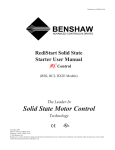


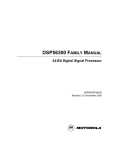

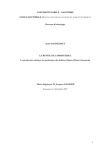
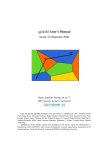
![EX MV MX3 User Manual [May16].vp](http://vs1.manualzilla.com/store/data/005646159_1-0d378a1c318c2dc00419aef6af60da73-150x150.png)
